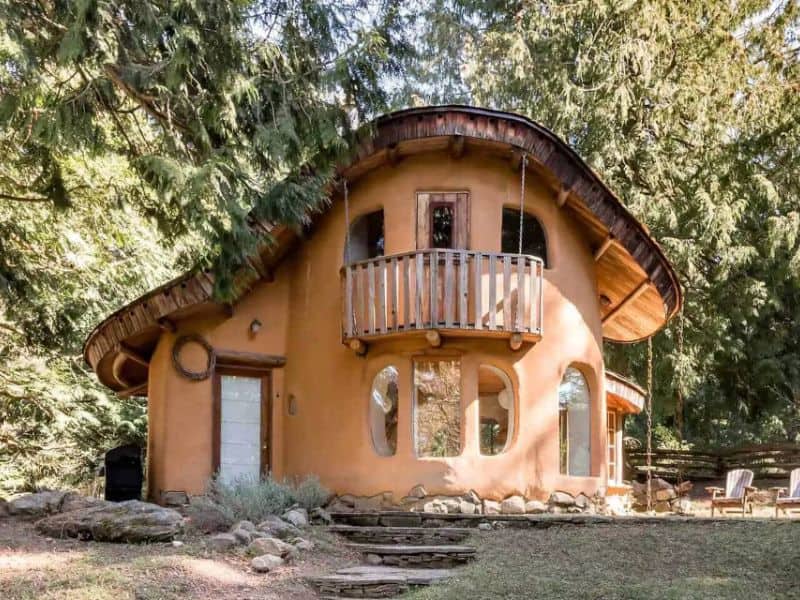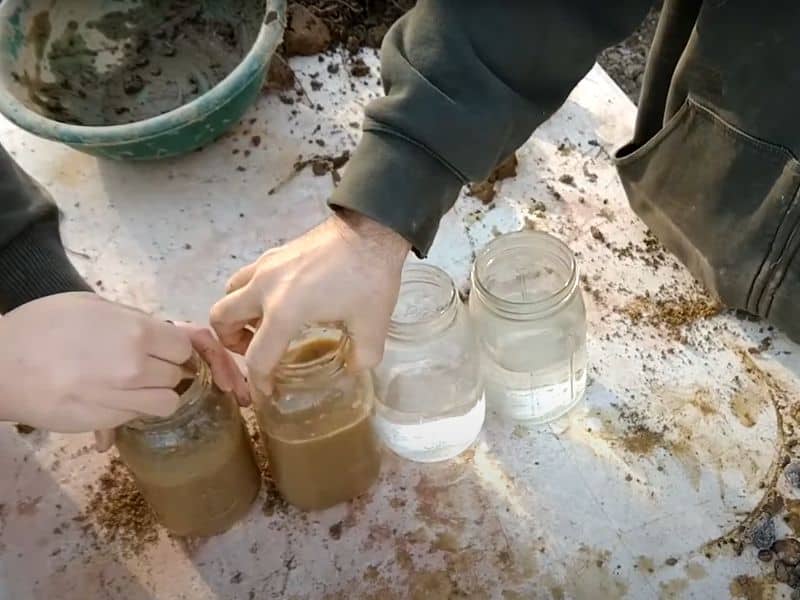What Is a Cob House? Sustainable Building Method Explained

The construction industry is responsible for 50% of climate change, 23% of air pollution, and 40% of drinking water pollution. As a result, there has been a growing interest in sustainable construction materials like cob to mitigate the construction industry’s impact on the environment.
However, if you’re new to cob construction, one question you may want answered is, “What is a cob house?”
A cob house is a type of house made from cob, a natural building material that combines water, clay soil, silt, coarse sand, and fibrous organic matter like straw. The mixture is beaten to form stiff mud that’s built into walls while wet. The approach doesn’t involve forming or ramming.
In the rest of this article, I’ll discuss what cob houses look like, their life expectancy, and the composition of materials used in cob house construction. I’ll also discuss why cob is an excellent building material and the best aggregate composition to use.
Let’s get started!
What Does a Cob House Look Like?

A cob house features curvy, organic shapes, thick sloping walls, and wall niches. Cob houses are often designed to mirror a lump or rounded mass, as is the definition of cob in old English.
Since they are made from earthen materials, cob houses have a rustic, earthy feel that blends beautifully with natural surroundings.
Typically, cob houses are one or two stories – it’s rare to come across a three-story cob house.
The roofs are usually made of thatch, slate, or tiles. They may also have earthen floors or other natural flooring such as stone or wood.
According to research, cob houses are built without mortar joints to make them strong and highly resistant to impacts like earthquakes.
Electrical conduits, doors, windows, and wooden anchors for cabinets are built along the way. Therefore, the result is a monolithic earthen wall that’s hard and strong.
A continuous interwoven layer of high-tensile-strength straw fibers reinforces the wall.
Cob House Durability

Cob houses are built to last a lifetime, provided they’re cared for appropriately.
For longevity, you must ensure your cob house is well protected from water.
Cob houses are highly susceptible to water damage due to the material’s hydrophobic and hydrophilic nature. Therefore, while cob exhibits excellent dehydration, it also becomes saturated at the same degree when exposed to water.
The oldest known cob house has existed for more than 10,000 years. This is evidence that with appropriate care, a cob house will serve you and your descendants for generations to come.
Some ways to care for your cob house and ensure longevity are:
- Create a water-safe foundation: Ensure the foundation is made from a water-tight material like concrete or stone. The ground around the foundation should also be well-drained or slanting away to prevent rainwater from seeping into the foundation.
- Create large, overhanging roof eaves: Roof eaves prevent rainwater from reaching the cob walls. They also prevent water ingress at the intersection between the wall and the roof. A rule of thumb is to have long roof overhangs extending 2 to 3 feet (0.61 to 0.91 meters) from the cob walls.
- Seal the walls and foundation: Consider sealing the walls and foundation for a water-tight house that stands the test of time. It’s advisable to use a breathable sealant so that moisture can escape from the walls. Linseed oil and lime plaster are excellent options.
Cob as a Construction Material
Although labor-intensive, cob makes an excellent building material because of the following qualities:
It’s Affordable
Building materials account for 70 percent of the total cost of a construction project.
As the prices of conventional materials like concrete keep soaring, more and more people are finding it hard to build homes. However, this is not the case with cob.
Being a natural material, you can get cob cheaply in large quantities. Alternatively, you can find the material freely on your land.
If you decide to extract the material from your land, you must perform a straightforward test to ascertain its properties and composition (discussed below).
Resistant to Seismic Activity

Seismic activity is a natural phenomenon that cannot be accurately predicted or controlled. With magnitudes as high as 9.5, such activity can cause massive property destruction.
As such, the only way to mitigate the impact of such events is by building with materials that are highly resistant to seismic activities.
Thanks to its construction technique, cob is one of the materials that are highly resistant to seismic activities.
Cob construction involves applying and sewing the mixture in courses while still pliable. More cob is added on top of the previous layer only after the bottom of the wall dries and becomes firm. The process is repeated until the desired height is attained.
As you can tell from the above explanation, cob doesn’t incorporate mortar joints. A major drawback of mortar joints is that they’re susceptible to water damage. When this happens, it weakens the wall’s structural integrity.
Walls with low structural stability are highly susceptible to earthquakes. Therefore, since cob walls don’t have mortar joints, they’re more stable and earthquake-resistant than other materials, including adobe.
High Thermal Storage Capacity
Building with materials that have high thermal energy storage capacity is an excellent way to minimize your home’s heating needs, particularly if you live in an area with large diurnal temperature variations. A low heating requirement means saving on your energy bills.
A material’s thermal energy storage (TES) is its ability to gain energy when increasing its temperature and lose the energy when decreasing the temperature. How does this apply to cob?
Cob has a high TES averaging 1205 Jkg−1K−1. This means it absorbs heat energy from the sun during the day and releases it at night.
Having been trained by a natural builder named Elke Cole, Jamie Ferguson confirms the enormous thermal storage capacity of cob by saying:
“The sun heats up the walls throughout the day, and by night, the walls begin to release that warmth into the house due to their ability to hold thermal mass. Touching the walls, you can feel a warmth coming from them. It’s extremely efficient.”
That said, as the cob house releases heat overnight, your HVAC system won’t use much energy to warm the house.
Extreme Fluidity in Form

The ability to create decorative sculptural elements and unique building shapes comes from the material’s fluidity.
Concrete is a highly rigid material, especially after curing. It can’t be sculpted or re-shaped into other shapes. However, that’s not the case with cob.
Cob is highly fluid, making it ideal for creating unique building shapes. Moreover, the material is easy to use and doesn’t require heavy machinery.
Cob Composition for Building
Given that cob is made from soil, silt, lime, and water, does it mean you can mix these components in any proportion for building? Absolutely not. Doing that is a recipe for a poor mix that results in weaker cob walls that can’t stand the test of time.
The composition and type of aggregates is crucial for a sturdy cob that builds stronger and more durable walls.
Subsoil is preferred for cob construction because it has minimal organic materials.
Topsoil appears dark because it contains mostly organic matter. Using this soil for your cob poses a structural risk because the organic matter can rot, creating voids within the wall.
The best subsoil for cob construction must have fine gravel, coarse stones, and silt. These components help enhance cob’s binding strength.
Once you have subsoil for your cob construction, it’s time to test its composition. Suitable subsoil for cob building should have the following composition:
- Sand soil: 25% to 30%
- Clay soil: 10% to 25%
- Gravel: 30% to 40%
- Silt: 10% to 20%
Performing a shake test on your soil sample is the best way to determine the amount of sand, clay, gravel, and silt.
The test involves filling the jar to approximately 1/3 full with the soil sample and then adding water to almost the top (leaving a gap for shaking).
Secure the lid, then thoroughly shake the soil and water mixture. Wait for the mixture to settle (about 30 minutes) and inspect the layers that form.
The clay layer forms at the topmost part, while the sand layer forms at the jar’s bottom.
An ideal cob soil should have more sand than clay. If the test shows otherwise, consider amending the soil by adding more sand before using it to make cob.
Here is a video demonstrating the soil shake test:

What Is a Cob House? – Final Thoughts
Cob construction is more than just a sustainable building method – it’s a nod to our past and a step towards a more sustainable future.
By using natural materials such as clay, straw, and sand, cob houses are not only environmentally friendly but also energy-efficient. Therefore, as we continue to search for ways to live sustainably, cob offers a unique and beautiful solution.
Now that you know what cob houses are, here is a list of 10 other non-toxic, sustainable building materials to build with.







